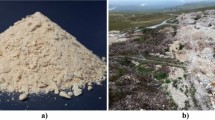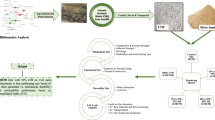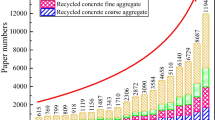Abstract
The present work assesses the feasibility of using mining and industrial residues as aggregates of coating mortars in terms of building thermal performance. For this purpose, we investigated four types of aggregates (river sand—REF, iron ore tailings—IOT, friable quartzite—QTZ, and steelmaking slag—SLG). Initially, the specific gravity (density) and thermal conductivity of the residue-based mortars were experimentally obtained. Subsequently, a sensitivity analysis was performed through energy simulations of two existing dwellings. Mortars with SLG and IOT presented the best performance due to their low thermal conductivity and, more importantly, their high density. Mortars with SLG presented 64% of thermal performance classifications as “superior” and “intermediate”, versus an average of 53% for the other aggregates. They were followed by those with IOT, REF and lastly those with QTZ. Therefore, these mortars are cost-effective and sustainable solutions to passively improve the thermal performance of buildings, as well as to mitigate the impacts of the disposal of these residues.













Similar content being viewed by others
References
IEA (2013) Transition to sustainable buildings—strategies and opportunities to 2050. International Energy Agency, Paris
Sadineni S, Madala S, Boehm R (2011) Passive building energy savings: a review of building envelope components. Renew Sustain Energy Rev 15:3617–3631
Nguyen AT, Reiter S (2014) Passive designs and strategies for low-cost housing using simulation-based optimization and different thermal comfort criteria. J Build Perform Simul 7(1):68–81
Figueirôa S (2014) Mining in Brazil, encyclopedia of the history of science, technology, and medicine in non-western cultures
Edraki M, Baumgartl T, Manlapig E, Bradshaw D, Franks DM, Moran CJ (2014) Designing mine tailings for better environmental, social and economic outcomes: a review of alternative approaches. J Clean Prod 84:411–420
Galvão JLB, Andrade HD, Brigolini GJ, Peixoto RAF, Mendes JC (2018) Reuse of iron ore tailings from tailings dams as pigment for sustainable paints. J Clean Prod 200:412–422
Tuladhar R, Yin S (2019) Sustainability of using recycled plastic fiber in concrete. In: Use of recycled plastics in eco-efficient concrete. Woodhead Publishing, pp 441–460. https://www.sciencedirect.com/book/9780081026762/use-of-recycled-plastics-in-eco-efficient-concrete#book-description
Gonçalves DR, Fontes WC, Mendes JC, Silva GJ, Peixoto RA (2016) Evaluation of the economic feasibility of a processing plant for steelmaking slag. Waste Manag Res 34(2):107–112
Sant’Ana Filho JN, Da Silva SN, Silva GC, Mendes JC, Peixoto RAF (2017) Technical and environmental feasibility of interlocking concrete pavers with iron ore tailings from tailings dams. J Mater Civ Eng 29(9):104
Silva M, De Souza B, Mendes J, Brigolini G, Da Silva S, Peixoto R (2016) Feasibility study of steel slag aggregates in precast concrete pavers. ACI Mater J 113(4):439–446
Fontes W, Mendes J, Silva S, Peixoto R (2016) Mortars for laying and coating produced with iron ore tailings from tailing dams. Constr Build Mater 112:988–995
Fontes W, Costa E, Mendes J, Fontes G, Brigolini G, Peixoto R (2018) Iron ore tailings in the production of cement tiles: a value analysis on building sustainability. Ambiente Construído 18(4):395–412
Weishi L, Guoyuan L, Ya X, Qifei H (2018) The properties and formation mechanisms of eco-friendly brick building materials fabricated from low-silicon iron ore tailings. J Clean Prod 204:685–692
Ma BG, Cai LX, Li XG, Jian SW (2016) Utilization of iron tailings as substitute in autoclaved aerated concrete: physico-mechanical and microstructure of hydration products. J Clean Prod 127:162–171
de Carvalho JMF, de Melo TV, Fontes WC, dos Santos Batista JO, Brigolini GJ, Peixoto RAF (2019) More eco-efficient concrete: an approach on optimization in the production and use of waste-based supplementary cementing materials. Constr Build Mater 206:397–409
Carvalho J, Borges M, Januzzi R, Peixoto R, Cury A (2014) Study of the mechanical behavior of blocks for structural masonry produced with steel slag in substitution of natural aggregates. Mason Int 30(2):31–38
Rondi L, Bregoli G, Sorlini S, Cominoli L, Collivignarelli C, Plizzari G (2016) Concrete with EAF steel slag as aggregate: a comprehensive technical and environmental characterisation. Compos B Eng 90:195–202
Faraone N, Tonello G, Furlani EMS (2009) Steelmaking slag as aggregate for mortars: effects of particle dimension on compression strength. Chemosphere 77(8):1152–1156
Ramirio RF, Pamplona DRP, Francklin Junior I, Collares EG (2008) Comparative study of quartzite tailings with other aggregates commercially used as building materials in the Southwest of Minas Gerais. Ciência et Praxis 1(1):25–32
Adom-Asamoah M, Tuffour YA, Afrifa RO, Kankam CK (2014) Strength characteristics of hand-quarried partially-weathered quartzite aggregates in concrete. Am J Civ Eng 2(5):134–142
Santos D (2015) Total substitution of the natural aggregate by friable quartzite for the production of mixed mortars for laying and coating. Federal University of Ouro Preto (Master's Thesis) (in Portuguese), Ouro Preto
Dias L, Mol R, Campos P, Mendes J, Peixoto R (2017) Quartz mining residue for production of tile mortars. In: Proceedings of 22nd CBECiMat, Natal
Corinaldesi V, Mazzoli A, Moriconi G (2011) Mechanical behaviour and thermal conductivity of mortars containing waste rubber particles. Mater Des 32(3):1646–1650
Benmansour N, Agoudjil B, Gherabli A, Kareche A, Boudenne A (2014) Thermal and mechanical performance of natural mortar reinforced with date palm fibers for use as insulating materials in building. Energy Build 81:98–104
Rashad A (2016) Cementitious materials and agricultural wastes as natural fine aggregate replacement in conventional mortar and concrete. J Build Eng 5:119–141
Franco L, Mendes J, Costa L, Pira R, Peixoto R (2019) Design and thermal evaluation of a social housing model conceived with bioclimatic principles and recycled aggregates. Sustain Cities Soc 51:101725
Lin LK, Kuo TM, Hsu YS (2016) The application and evaluation research of coffee residue ash into mortar. J Mater Cycles Waste Manag 18(3):541–551
Marvila MT, Alexandre J, de Azevedo AR, Zanelato EB (2019) Evaluation of the use of marble waste in hydrated lime cement mortar based. J Mater Cycles Waste Manag 21(5):1250–1261
Sá AV, Azenha M, de Sousa H, Samagaio A (2012) Thermal enhancement of plastering mortars with phase change materials: experimental and numerical approach. Energy Build 49:16–27
Fernandes MS, Rodrigues E, Gaspar AR, Costa JJ, Gomes Á (2019) The impact of thermal transmittance variation on building design in the Mediterranean region. Appl Energy 239:581–597
ABNT (2004) NBR 10007 - sampling of solid waste. Brazilian Association of Technical Standards, Rio de Janeiro
ABNT (2003) NBR NM 248 - aggregates - sieve analysis of fine and coarse aggregates. Brazilian Association of Technical Standards, Rio de Janeiro
ABNT (2009) NBR NM 52 - fine aggregate - determination of the bulk specific gravity and apparent specific gravity. Brazilian Association of Technical Standards, Rio de Janeiro
ABNT (2005) NBR 13276 - mortars applied on walls and ceilings - preparation of mortar for unit masonry and rendering with standard consistence index. Rio de Janeiro
ABNT (2005) NBR 13280 - mortars applied on walls and ceilings - determination of the specific gravity in the hardened stage. Brazilian Association of Technical Standards, Rio de Janeiro
ABNT (2009) NBR 9778 - hardened mortar and concrete - determination of absorption, voids and specific gravity. Brazilian Association of Technical Standards, Rio de Janeiro
ABNT (2005) NBR 15220 - thermal performance in buildings. Rio de Janeiro
ABNT (2013) NBR 15575 - residential buildings—performance. Brazilian Association of Technical Standards, Rio de Janeiro
Oliveira RD, de Souza RVG, Mairink AJM, Rizzi MTG, da Silva RM (2015) Thermal comfort for users according to the Brazilian housing buildings performance standards. Energy Proc 78:2923–2928
Yang L, Yan H, Lam JC (2014) Thermal comfort and building energy consumption implications–a review. Appl Energy 115:164–173
Siwinska A, Garbalinska H (2011) Thermal conductivity coefficient of cement-based mortars as air relative humidity function. Heat Mass Transf 47(1):1077–1087
Sébaı̈bi Y, Dheilly RM, Quenuedec M (2003) Study of the water-retention capacity of a lime–sand mortar: influence of the physicochemical characteristics of the lime. Cement Concr Res 33(5):689–696
Mendes J, Barreto R, Paula A, Elói F, Brigolini G, Peixoto R (2019) On the relationship between morphology and thermal conductivity of cement-based composites. Cement Concr Compos 104:103365
Burger N, Laachachi A, Ferriol M, Lutz M, Toniazzo V, Ruch D (2016) Review of thermal conductivity in composites: mechanisms, parameters and theory. Prog Polym Sci 61:1–28
Smith DS, Alzina A, Bourret J, Nait-Ali B, Pennec F, Tessier-Doyen N et al (2013) Thermal conductivity of porous materials. J Mater Res 28(17):2260–2272
Lamberts R, Dutra L, Pereira F (1997) Energy efficiency in architecture. Eletrobrás Procel, Rio de Janeiro
Lam J, Wan K, Tsang C, Yang L (2008) Building energy efficiency in different climates. Energy Convers Manag 49(8):2354–2366
Bustamante W, Bobadilla A, Navarrete B, Vidal S, Saelzer G (2009) Thermal improvement of perforated ceramic bricks. Revista de la Construcción 8(1):24–35
Tubelo R, Rodrigues L, Gillott M, Soares JCG (2018) Cost-effective envelope optimisation for social housing in Brazil's moderate climates zones. Build Environ 133:213–227
Paulsen JS, Sposto RM (2013) A life cycle energy analysis of social housing in Brazil: case study for the program “MY HOUSE MY LIFE”. Energy and Buildings 57:95–102
Patinoa EDL, Siegel JA (2018) Indoor environmental quality in social housing: a literature review. Build Environ 131:231–241
Mendes J, Moro T, Figueiredo A, Silva K, Silva G, Silva G, Peixoto R (2017) Mechanical, rheological and morphological analysis of cement-based composites with a new LAS-based air entraining agent. Constr Build Mater 145:648–661
Mendes J, Pinto P, Silva H, Barreto R, Moro T, Peixoto R (2019) macroporous mortars for laying and coating. Revista de la Construccion 18(1):29–41
Defáveri KCS, Mendes JC, de Carvalho JMF, Fontes WC, Peixoto RAF, Brigolini GJS (2019) Glass wool residue: a potential supplementary cementitious material. ACI Mater J 116(4):43–49
Silva KDC, Silva GC, Natalli JF, Mendes JC, Silva GJB, Peixoto RAF (2018) Rock wool waste as supplementary cementitious material for portland cement-based composites. ACI Mater J 115(5):653–661
Khedari J, Suttisonk B, Pratinthong N, Hirunlabh J (2001) New lightweight composite construction materials with low thermal conductivity. Cement Concr Compos 23(1):65–70
Raheem AA, Adesanya DA (2011) A study of thermal conductivity of corn cob ash blended cement mortar. Pac J Sci Technol 12(2):106–111
Acknowledgements
This study was financed in part by the Coordenação de Aperfeiçoamento de Pessoal de Nível Superior – Brasil (CAPES) – Finance Code 001. We gratefully acknowledge the agencies FAPEMIG (Fundação de Amparo à Pesquisa do Estado de Minas Gerais, Brazil) and CNPq (Conselho Nacional de Desenvolvimento Científico e Tecnológico, Brazil) for providing financial support. We are also grateful for the infrastructure and collaboration of the Research Group on Solid Wastes (RECICLOS—CNPq) and the Comfort Research Centre of UFOP (NUPECON).
Author information
Authors and Affiliations
Corresponding author
Ethics declarations
Conflict of interest
The authors declare that they have no conflict of interest.
Additional information
Publisher's Note
Springer Nature remains neutral with regard to jurisdictional claims in published maps and institutional affiliations.
Rights and permissions
About this article
Cite this article
Castro Mendes, J., Barreto, R.R., de Freitas Vilaça, V. et al. Coating mortars based on mining and industrial residues. J Mater Cycles Waste Manag 22, 1569–1586 (2020). https://doi.org/10.1007/s10163-020-01051-0
Received:
Accepted:
Published:
Issue Date:
DOI: https://doi.org/10.1007/s10163-020-01051-0




